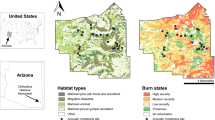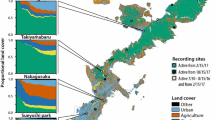Abstract
Context
Semi-arid landscapes are naturally heterogeneous with several factors influencing this variation. Fauna responses and adaptations vary in xeric environments, and the scale of observation is important. Biodiversity monitoring at several scales can be challenging, and acoustics are an alternative to this issue.
Objectives
We investigated how audible biodiversity is influenced by environmental factors (e.g.: vegetation metrics, climatic variables, etc.) across a fine spatial scale, aiming to provide a better understanding of the variation in audible species across recording locations placed close together. These results will improve the current knowledge on ecoacoustics as a tool for measuring ecological processes in this biome, and better inform conservation plans.
Methods
We collected data in the semi-arid region in Queensland, Australia placing 24 recorders 200 m apart for 48 h. We also sampled environmental attributes (e.g.: temperature and vegetation structure metrics) and used acoustic indices in a time-series algorithm to categorise sound into classes. Bird species and feeding guilds were also identified.
Results
We found significant differences between proximate sensors, demonstrating that soundscape differences occur across fine spatial scales. Birds and insects were the predominant biophonic sound observed and both groups were associated with shrub cover and subcanopy height. Environments with higher shrub and subcanopy cover had a higher percentage of all birds’ feeding guilds and insects. Sixty-three bird species were identified, including a threatened bird species in Queensland.
Conclusion
We show biodiversity is influenced by vegetation heterogeneity across fine spatial scales in semi-arid regions, identifying which attributes sustain higher levels of biodiversity activity. Our study reveals the practicality of acoustic surveys for this biodiversity monitoring by covering a large area in 48 h. However, we caution that scale is an important consideration when designing surveys.






Similar content being viewed by others
References
Accad AK, JA.R., R., D., Neldner, V. J., & Li, J. (2021). Remnant Regional Ecosystem Vegetation in Queensland, Analysis 1997–2019. https://www.qld.gov.au/environment/plants-animals/plants/ecosystems/remnant-vegetation
Aide TM, Hernández-Serna A, Campos-Cerqueira M, Acevedo-Charry O, Deichmann JL (2017) Species richness (of insects) drives the use of acoustic space in the tropics. Remote Sens 9(11):1–12
Alcocer I, Lima H, Sugai LSM, Llusia D (2022) Acoustic indices as proxies for biodiversity: a meta-analysis. Biol Rev. https://doi.org/10.1111/brv.12890
Andersen AN, Lonsdale WM (1990) Herbivory by insects in Australian tropical savannas: a review. J Biogeogr 17(4):433–444
Antos MJ, Bennett AF (2006) Foraging ecology of ground-feeding woodland birds in temperate woodlands of southern Australia. Emu 106(1):29–40
Asrar G, Fuchs M, Kanemasu ET, Hatfield JL (1984) Estimating absorbed photosynthetic radiation and leaf area index from spectral reflectance in wheat 1. Agron J 76(2):300–306
Bellisario KM, Pijanowski BC (2019) Contributions of MIR to soundscape ecology. Part I: potential methodological synergies. Ecol Inform 51:96–102
Bennett AF, Hinsley SA, Bellamy PE, Swetnam RD, Mac Nally R (2004) Do regional gradients in land-use influence richness, composition and turnover of bird assemblages in small woods? Biol Conserv 119(2):191–206
Braithwaite RW, Miller L, Wood JT (1988) The structure of termite communities in the Australian tropics. Aust J Ecol 13(4):375–391
Browning E, Gibb R, Glover-Kapfer P, Jones KE, Bas G, Billington Z, Burivalova D, Clink J, De Ridder J, Halls T, Hastings D, Jacoby A, Kalan A, Kershenbaum S, Linke S, Lucas R, Machado P, Owens C, Sutter P et al (2017) Passive acoustic monitoring in ecology and conservation. WWF Conserv Technol Ser 1(2):1–75
Campbell M, Francis CM (2012) Using microphone arrays to examine effects of observers on birds during point count surveys. J Field Ornithol 83(4):391–402
Cottam G, Curtis JT (1956) The use of distance measures in phytosociological sampling. Ecology 37(3):451–460
Couteron P, Lejeune O (2001) Periodic spotted patterns in semi-arid vegetation explained by a propagation-inhibition model. J Ecol 89(4):616–628
Deichmann JL, Acevedo-Charry O, Barclay L, Burivalova Z, Campos-Cerqueira M, d’Horta F, Game ET, Gottesman BL, Hart PJ, Kalan AK, Linke S, Nascimento LD, Pijanowski B, Staaterman E, Mitchell Aide T (2018) It’s time to listen: there is much to be learned from the sounds of tropical ecosystems. Biotropica. https://doi.org/10.1111/btp.12593
Doerr VAJ, Doerr ED, Jenkins SH (2006) Habitat selection in two Australasian treecreepers: what cues should they use? Emu 106(2):93–103
Doohan B, Kemp J, Fuller S (2019) Diversity favours the old: metrics of avian diversity increase in aging regrowth Acacia woodlands of semi-arid eastern Australia. Glob Ecol Conserv 20:e00798
Farina A, Pieretti N, Piccioli L (2011) The soundscape methodology for long-term bird monitoring: a Mediterranean Europe case-study. Ecol Inform 6(6):354–363
Ferreira LM, Oliveira EG, Lopes LC, Brito MR, Baumgarten J, Rodrigues FH, Sousa-Lima RS (2018) What do insects, anurans, birds, and mammals have to say about soundscape indices in a tropical savanna. J Ecoacoustics 2(1):1–1
Gage SH, Axel AC (2014) Visualization of temporal change in soundscape power of a Michigan lake habitat over a 4-year period. Ecol Inform 21:100–109
Gasc A, Gottesman BL, Francomano D, Jung J, Durham M, Mateljak J, Pijanowski BC (2018) Soundscapes reveal disturbance impacts: biophonic response to wildfire in the Sonoran Desert Sky Islands. Landsc Ecol 33(8):1399–1415
Gaston KJ (2000) Global patterns in biodiversity. Nature 405(6783):220–227
Gibb R, Browning E, Glover-Kapfer P, Jones KE (2019) Emerging opportunities and challenges for passive acoustics in ecological assessment and monitoring. Methods Ecol Evol 10(2):169–185
Graphical Climate Statistics for Australian Locations (n.d.) http://www.bom.gov.au/jsp/ncc/cdio/cvg/av?p_stn_num=044026&p_prim_element_index=18&p_display_type=statGraph&period_of_avg=ALL&normals_years=allYearOfData&staticPage=. Accessed 20 Apr 2020
Hill AP, Prince P, Piña Covarrubias E, Doncaster CP, Snaddon JL, Rogers A (2018) AudioMoth: evaluation of a smart open acoustic device for monitoring biodiversity and the environment. Methods Ecol Evol 9(5):1199–1211
Kenkel NC, Orloci L (1986) Applying metric and nonmetric multidimensional scaling to ecological studies: some new results. Ecology 67(4):919–928
Klausmeier CA (1999) Regular and irregular patterns in semiarid vegetation. Science 284:1826–1828
Kletter AY, von Hardenberg J, Meron E, Provenzale A (2009) Patterned vegetation and rainfall intermittency. J Theor Biol 256(4):574–583
Leavesley AJ, Cary GJ, Edwards GP, Gill AM (2010) The effect of fire on birds of mulga woodlandin arid central Australia. Int J Wildland Fire 19(7):949–960
Menkhorst P, Rogers D, Clarke R, Davies J, Marsack P, Franklin K (2017) The Australian bird guide. CSIRO Publishing, Melbourne
Meron E, Yizhaq H, Gilad E (2007) Localized structures in dryland vegetation: forms and functions. Chaos 17(3):1–9
Morton ES (1975) Ecological sources of selection on avian sounds. Am Nat 109(965):17–34
Müller J, Stadler J, Brandl R (2010) Composition versus physiognomy of vegetation as predictors of bird assemblages: the role of lidar. Remote Sens Environ 114(3):490–495
National Committee on Soil and Terrain (2009) Australian soil and land survey field handbook. CSIRO Publishing, Melbourne
Pavey CR, Nano CEM (2009) Bird assemblages of arid Australia: vegetation patterns have a greater effect than disturbance and resource pulses. J Arid Environ 73(6–7):634–642
Pieretti N, Farina A, Morri D (2011) A new methodology to infer the singing activity of an avian community: the Acoustic Complexity Index (ACI). Ecol Ind 11(3):868–873
Pijanowski BC, Brown CJ (2022) Grand challenges in acoustic remote sensing: discoveries to support a better understanding of our changing planet. Front Remote Sens 2:1–9
Pijanowski BC, Villanueva-Rivera LJ, Dumyahn SL, Farina A, Krause BL, Napoletano BM, Gage SH, Pieretti N, Pijanowski BC, Villanueva-Rivera LJ, Dumyahn SL, Farina A, Krause BL, Napoletano BM, Gage SH, Pieretti N, Pijanowski BC, Villanueva-Rivera LJ, Dumyahn SL, Farina A, Krause BL, Napoletano BM, Gage SH, Pieretti N, Pijanowski BC, Villanueva-Rivera LJ, Dumyahn SL, Farina A, Krause BL, Napoletano BM, Gage SH et al (2011) Soundscape ecology: the science of sound in the landscape. Bioscience 61(3):203–216.
Queensland Department of Environment and Science (2018) Statewide landcover and trees study: overview of methods. Department of Environment and Science, State of Queensland
Rietkerk M, Dekker SC, De Ruiter PC, Van De Koppel J (2004) Self-organized patchiness and catastrophic shifts in ecosystems. Science 305(5692):1926–1929
Rietkerk M, van de Koppel J (2008) Regular pattern formation in real ecosystems. Trends Ecol Evol 23(3):169–175
Sagario MC, Cueto VR, Zarco A, Pol R, Marone L (2020) Predicting how seed-eating passerines respond to cattle grazing in a semi-arid grassland using seed preferences and diet. Agric Ecosyst Environ 289:106736
Scarpelli MD, Liquet B, Tucker D, Fuller S, Roe P (2021) Multi-index ecoacoustics analysis for terrestrial soundscapes: a new semi-automated approach using time-series motif discovery and random forest classification. Front Ecol Evol 9:1–14
Scarpelli MDA, Liquet B, Tucker D, Fuller S, Roe P (2021) Multi-index ecoacoustics analysis for terrestrial soundscapes: a new semi-automated approach using time-series motif discovery and random forest classification. Front Ecol Evol 9:1–14
Schaffers AP, Raemakers IP, Sýkora KV, Ter Braak CJF (2008) Arthropod assemblages are best predicted by plant species composition. Ecology 89(3):782–794
Smith JE (2015) Effects of environmental variation on the composition and dynamics of an arid-adapted Australian bird community. Pac Conserv Biol 21(1):74–86
Stafford Smith DM, Morton SR (1990) A framework for the ecology of arid Australia. J Arid Environ 18(3):255–278
Steffen W, Richardson K, Rockström J, Cornell SE, Fetzer I, Bennett EM, Biggs R, Carpenter SR, De Vries W, De Wit CA, Folke C, Gerten D, Heinke J, Mace GM, Persson LM, Ramanathan V, Reyers B, Sörlin S (2015) Planetary boundaries: guiding human development on a changing planet. Science. https://doi.org/10.1126/science.1259855
Sueur J, Farina A (2015) Ecoacoustics: the ecological investigation and interpretation of environmental sound. Biosemiotics 8(3):493–502
Sueur J, Farina A, Gasc A, Pieretti N, Pavoine S (2014) Acoustic indices for biodiversity assessment and landscape investigation. Acta Acust Acust 100(4):772–781
Sueur J, Krause B, Farina A (2019) Climate change is breaking earth’s beat. Trends Ecol Evol 34(11):971–973
Sueur J, Pavoine S, Hamerlynck O, Duvail S (2008) Rapid acoustic survey for biodiversity appraisal. PLoS ONE 3(12):e4065
Tischler M, Dickman CR, Wardle GM (2013) Avian functional group responses to rainfall across four vegetation types in the Simpson Desert, central Australia. Aust Ecol 38(7):809–819
QutEcoacoustics/audio-analysis: Ecoacoustics Audio Analysis Software v20.11.2.0, (2020) (testimony of Michael Towsey, Anthony Truskinger, Mark Cottman-Fields, & Paul Roe). https://doi.org/10.5281/ZENODO.4274299
Towsey M, Wimmer J, Williamson I, Roe P (2014a) The use of acoustic indices to determine avian species richness in audio-recordings of the environment. Eco Inform 21(100):110–119
Towsey M, Zhang L, Cottman-Fields M, Wimmer J, Zhang J, Roe P (2014b) Visualization of long-duration acoustic recordings of the environment. Procedia Comput Sci 29:703–712
Towsey M, Znidersic E, Broken-Brow J, Indraswari K, Watson DM, Phillips Y, Truskinger A, Roe P (2018) Long-duration, false-colour spectrograms for detecting species in large audio data-sets. J Ecoacoustics. https://doi.org/10.22261/JEA.IUSWUI
Urban DL, Neill RVO, Shugart HH (1987) A hierarchical perspective can help scientists understand spatial patterns. Bioscience 37(2):119–127
von Hardenberg J, Meron E, Shachak M, Zarmi Y (2001) Diversity of vegetation patterns and desertification. Phys Rev Lett 87(19):198101-1-198101–198104
Zhao Z, Xu Z. Yong, Bellisario K, Zeng R. Wen, Li N, Zhou W. Yang, Pijanowski BC (2019) How well do acoustic indices measure biodiversity? Computational experiments to determine effect of sound unit shape, vocalization intensity, and frequency of vocalization occurrence on performance of acoustic indices. Ecol Indic 107:105588
Znidersic E, Watson DM (2022) Acoustic restoration: using soundscapes to benchmark and fast-track recovery of ecological communities. Ecol Lett. https://doi.org/10.1111/ele.14015
(https://birdsqueensland.org.au/threatened_species.php) visited on 12/07/2021
Acknowledgements
We gratefully acknowledge Queensland University of Technology for funding and Australian Wildlife Conservancy for access to the sanctuary.
Author information
Authors and Affiliations
Contributions
MDAS, SF, DT and PR conceived the ideas and elaborated experimental design; MDAS did the analysis; BD helped with fieldwork and identified the birds; DT and MDAS conducted most of the fieldwork; All authors contributed with writing and revision of the manuscript.
Corresponding author
Ethics declarations
Competing interests
The authors declare no competing interests.
Additional information
Publisher's Note
Springer Nature remains neutral with regard to jurisdictional claims in published maps and institutional affiliations.
Supplementary Information
Below is the link to the electronic supplementary material.
Rights and permissions
Springer Nature or its licensor (e.g. a society or other partner) holds exclusive rights to this article under a publishing agreement with the author(s) or other rightsholder(s); author self-archiving of the accepted manuscript version of this article is solely governed by the terms of such publishing agreement and applicable law.
About this article
Cite this article
Scarpelli, M.D.A., Tucker, D., Doohan, B. et al. Spatial dynamics of soundscapes and biodiversity in a semi-arid landscape. Landsc Ecol 38, 463–478 (2023). https://doi.org/10.1007/s10980-022-01568-9
Received:
Accepted:
Published:
Issue Date:
DOI: https://doi.org/10.1007/s10980-022-01568-9




